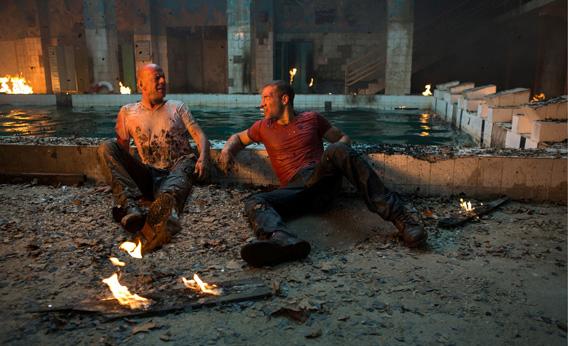A Good Day To Die Hard
Time to save the goddamn world again.

Photo by Frank Masi/SMPSP TM/Twentieth Century Fox Film Corporation
After you watch A Good Day To Die Hard, come back and listen to Dana, Chris Wade, and Alice Tynan discuss the movie in this Spoiler Special by clicking the play button below. You can also download the podcast.
What is it about John McClane—the catchphrase-slinging, glass-hating protagonist of the now 25-year-old Die Hard franchise—that allows him to emerge unscathed, not just from exploding skyscrapers but from the smoking wreckage of a movie as terrible as A Good Day To Die Hard? Few fans of the series would disagree that this sclerotic fifth installment should probably be the last. Yet I found myself hoping that Bruce Willis’ laconic character—who, after a quarter-century of fleeing fireballs down elevator shafts, has not yet worn out his welcome as an action-movie folk hero—gets one more chance to come back and die hard with dignity. (I may find myself forced to contend with the fulfillment of this wish, as Willis has indicated in interviews that he wouldn’t be averse to reprising the role should a sixth script come his way.)
A Good Day To Die Hard, directed by John Moore (Behind Enemy Lines, Max Payne) and written by Skip Woods (The A-Team), takes McClane to Moscow, where he must rescue his son, CIA agent Jack McClane (Australian actor Jai Courtney), from a tangled web of intrigue involving an imprisoned Russian dissident (Sebastian Koch), a corrupt politician (Sergei Kolesnikov), and a rumored stash of weapons-grade plutonium. The absence of a single noteworthy villain is perhaps this movie’s most salient flaw (along with the jumbled, barely coherent editing of a seemingly endless chase through a Moscow traffic jam). Forget about Hans Gruber, the magisterially slimy German terrorist so nobly incarnated by Alan Rickman in the first Die Hard; is it too much to ask for a bad guy as amusing as the anarchist hacker Timothy Olyphant played in Live Free or Die Hard back in 2007? Instead Woods’ script distributes the audience’s antipathy among three or four separate evildoers whose character traits at times seem pulled at random from a villain-quirk generator. One high-ranking Russian thug (Radivoje Bukvic) likes to threaten his victims while munching a raw carrot and dancing soft-shoe, which, if nothing else, gives Willis the chance to utter one of the film’s few unrecycled McClane-isms: “Whoa, Nijinksy.”
A Good Day To Die Hard’s sloppy, slam-bang visual style grabs at whatever action-movie cliché suits the needs of the moment: The stylization of a Reservoir Dogs-esque slo-mo shot will suddenly give way to the faux-documentary “realism” of handheld shaky-cam, with a reverse zoom thrown in every now and then just to remind us how excited we’re supposed to be. And while plausibility is rarely a priority in movies of this type, the director tests his audience’s patience by staging stunts with no attention whatsoever to the laws of physics, so that, for example, a multistory fall from a building results in little more than a couple of photogenic dings to the forehead.
All of the Die Hard films so far have been about the action hero as reluctant badass—the average Joe and barely adequate family man who, every few years, finds himself in the unenviable position of having to save the goddamn world again. This time, McClane ventures out in search of trouble, all for the love of his semi-estranged son (“The things we do for our kids,” he mutters as he attempts to drive a truck off a helicopter). Springing the existence of John McClane Jr. on the audience five movies in is a bold move; in order to care about the future of this father-son relationship, we need to learn a little something about its past. How long ago did the two men stop speaking? What was the reason for their falling-out? But aside from the odd flinty exchange as they await the next ambush (“Need a hug?” “We’re not a hugging family”), the McClanes spend most of their time inflicting property damage on the Russian capital, with a disregard for civilian casualties that does nothing to earn them our sympathy. Nor does it help that the bullet-headed, python-armed Courtney is an inexpressive slab of manhood on the Sam Worthington model. McClane fils has inherited his father’s prematurely receding hairline and willingness to leap through plate-glass windows, but neither his world-weary sense of humor nor his melancholy eyes.